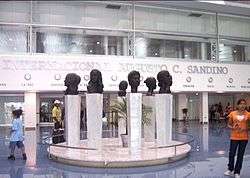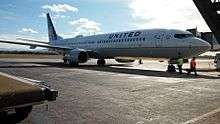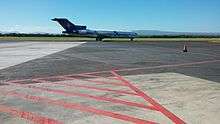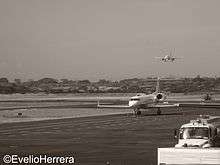Augusto C. Sandino International Airport
| Augusto C. Sandino International Airport Aeropuerto Internacional Augusto C. Sandino | |||||||||||
|---|---|---|---|---|---|---|---|---|---|---|---|
 | |||||||||||
 MGA | |||||||||||
| Summary | |||||||||||
| Airport type | Military/Public | ||||||||||
| Owner | Republica de Nicaragua | ||||||||||
| Operator | EAAI (Empresa Administradora de Aeropuertos Internacionales) | ||||||||||
| Serves | Managua | ||||||||||
| Location |
| ||||||||||
| Hub for | |||||||||||
| Elevation AMSL | 59 m / 194 ft | ||||||||||
| Coordinates | 12°08′29″N 086°10′05″W / 12.14139°N 86.16806°W | ||||||||||
| Website | http://www.eaai.com.ni | ||||||||||
| Runways | |||||||||||
| |||||||||||
Augusto C. Sandino International Airport (Spanish: Aeropuerto Internacional Augusto C. Sandino) (IATA: MGA, ICAO: MNMG) or ACS is the main airport in Managua, Nicaragua. Named as Las Mercedes Airport in 1968 it was later renamed Augusto C. Sandino International Airport during the Sandinista regime in the 1980s and again in 2001 to Managua International Airport by then president Arnoldo Alemán. Its name was changed once more in February 2007 to its current name by President Daniel Ortega to honor one of Nicaragua's national heroes, Augusto Cesar Sandino.[1]
The runway at the airport is 8,012 ft long, and it is located at an elevation of 194 feet. With 1.4 million passengers in 2013, ACS is currently the fifth busiest airport by passenger traffic in Central America and it also serves as a focus city for the Panamanian airline Copa Airlines. Augusto C. Sandino International Airport has direct scheduled service to destinations in the United States, Canada, Mexico, Central America and South America.
History
Before ACS, there was the old Xolotlan Airport, about 2 miles east of Managua, built in 1915 which very soon became too small for Managua's airline service growth. Thus, on January 22, 1942, the Nicaraguan Government and Pan American Airways signed a contract to construct an airport by Las Mercedes Country Estate which inspired the name for Las Mercedes Airport.[2] Las Mercedes was further upgraded, re-designed to handle Boeing 707 aircraft, and re-inaugurated on July 4, 1968 by Anastasio Somoza Debayle.[3]
In the early 1970s, Las Mercedes was expanded to more modern standards, such as four health inspectors, eight immigration officers and ten customs inspectors.[4] It was considered fully equipped, having air conditioning, background music, loudspeakers and conveyor belts for baggage handling.[5] It also had a restaurant on its upper floor where visitors and travelers could see airport movement.
.jpg)
The expanded airport could serve three aircraft at once and by 1975 LANICA, the National Airline of Nicaragua, as well as many well known carriers Pan Am, KLM (Royal Dutch Airlines), Taca Airlines, Sahsa, Avianca, Iberia, SAM, TAN, Varig, and smaller local carriers, flew into Las Mercedes. When the Sandinistas took power, the airport was named after Augusto César Sandino, a Nicaraguan revolutionary and guerrilla leader, after whom the Sandinista movement is named. The Sandinistas however did not maintain the airport, and it began to deteriorate until it was expanded and remodeled in 1996, when, among other things, two new boarding bridges were installed.[4] The airport was renamed "Managua International Airport" in 2001 by then President Arnoldo Alemán and renamed again in 2007 to its current name by President Daniel Ortega In mid 2007, President Daniel Ortega renamed the airport in honor of Sandino. Nicaraguan artist Róger Pérez de la Rocha has created many two large portraits of Augusto César Sandino, and Rubén Darío which they lay at the airports lobby.[6] .

Las Mercedes served for a very long time as a hub for Nicaragua's flag carriers Lanica (until 1978), Aeronica from 1979 to the 80's and NICA afterwards. When NICA became a member of Grupo TACA during the 1990s, the number of important connections to the rest of Latin America from which ACS grew considerably.
According to EAAI (Empresa Administradora de Aeropuertos Internacionales) ACS is the most modern airport in Central America and the 4th safest in the world. It is located just 11 km (7 mi) from Managua's downtown, has a runway which measures 8,015 ft (2,443 m) in length and is at an elevation of 194 ft (59 m).[7]
Embraer 190s, Airbus A300, Airbus A310, Airbus A320, Airbus A330, Airbus 340 Boeing 737s, Boeing 747s, Boeing 757s, Boeing 767s, Lockheed L-1011 TriStars and McDonnell Douglas DC-10s can land at the airport.
Expansion

A large expansion programme was underway by 2003 and as of July 2006 the final phase was completed with 7 gates equipped with jetways, and room for 20 airplanes to park. It had been reported in the recent past that the runway would be lengthened by 800 m (2,625 ft), but to date this projected has not begun, despite the government's great achievements in building new airports elsewhere in Nicaragua, or greatly overhauling existing airport/airfield infrastructure in other locations as well.[8]
About 360 individuals are employed at the airport. Facilities within the airport include a tourist information desk, bank, restaurants, bars, post office, souvenir shops, duty-free shops, lounges and more. To make use of the VIP lounge there are five rate options: Normal, Corporate, Affiliated Credit Cards, Minors and Infants. The types of services in the VIP lounge include checking baggage and documents with customs and immigration plus the airline; a bar service; snacks etc.[9]
Airlines and destinations




| Airlines | Destinations | Terminal1 |
|---|---|---|
| Aero Caribbean | Havana, San Pedro Sula | I |
| Aeroméxico Connect | Mexico City | I |
| Air Transat | Seasonal: Montréal-Trudeau | I |
| American Airlines | Dallas/Fort Worth,[10] Miami | I |
| Avianca | Miami, San José (CR), San Salvador, Guatemala City | I |
| Conviasa | Caracas | I |
| Copa Airlines | Guatemala City, Panama City, San José (CR) | I |
| Delta Air Lines | Atlanta Seasonal: Los Angeles[11] | I |
| La Costeña | Bluefields, Bonanza, Emerald Coast, Corn Island, Puerto Cabezas, San Juan de Nicaragua (Greytown), Ometepe, Rosita, San Carlos, Siuna, Waspan
Charter: Montelimar Beach International: Tegucigalpa | D |
| Nature Air | San José (Costa Rica) | I |
| Spirit Airlines | Fort Lauderdale, Houston–Intercontinental | I |
| United Airlines | Houston-Intercontinental | I |
1 D = Domestic Terminal, I = International Terminal.
Cargo
| Airlines | Destinations |
|---|---|
| Amerijet International | Miami |
| UPS Airlines | Miami |
Airline traffic departures and arrivals
| Airline | Percentage of Passengers Transported (2015) |
| | 30% |
| | 20% |
| | 15% |
| | 14% |
| | 7% |
| | 6% |
| | 3% |
| | 2% |
| | 1% |
| | 1% |
| | 1% |
| Total | 100.0% |
Busiest routes
- weekly departing seats.
| Rank | City | Passengers | Airlines |
|---|---|---|---|
| 1 | |
4,446 | American Airlines, Avianca El Salvador |
| 2 | |
2,656 | Spirit Airlines, United Airlines |
| 3 | |
2,595 | Avianca Costa Rica, Copa Airlines, Nature Air. |
| 4 | |
1,548 | Copa Airlines |
| 5 | |
1,548 | Avianca Guatemala, Copa Airlines |
| 6 | |
1,356 | Avianca El Salvaldor |
| 7 | |
1,050 | Delta Air Lines |
| 8 | |
890 | Spirit Airlines |
| 9 | 456 | Aeromexico | |
| 10 | TBD | Delta Air Lines | |
Incidents and accidents
- On March 5, 1959, Vickers Viscount YS-09C of TACA International Airlines crashed shortly after take-off from Managua Airport when both port engines failed. Fifteen of the 19 people on board were killed.[12]
- On February 15, 1974, a Douglas DC-3 of APSA was damaged beyond economic repair when it crash-landed at Managua Airport.[13]
- On July Sunday 18, 1993, a Boeing 737-200 of SAHSA, the aircraft landed firmly on runway 09, skidded to the right off the runway. The nosegear collapsed and both engines were torn off. The aircraft came to rest 200 feet right of the runway.[14]
- On June 5, 2006 a McDonnell Douglas DC10-10F (registered N68047) en route Miami – Managua touched down hard at Managua and was unable to stop before the end of the runway. The aircraft overran by about 300 meters, the nose gear collapsed causing substantial damage to the engines as well as a possible fuel rupture in the wing.[15]
- On July 24, 2007 a Boeing 737-700, Continental flight 876, with 120 passengers and a crew of 6 flying from Panama City to Houston had to land in the Augusto C. Sandino International Airport because one of the internal security windows suffered a rupture.[16]
- On September 22, 2012, A TACA Airlines Airbus A321-200 flight TA-396, registration N564TA from Managua (Nicaragua) to Miami International Airport Miami, Florida (US), rejected takeoff from Managua at high speed after an engine (V2533) ingested a bird. The aircraft slowed safely and returned to the apron. A passenger reported they were told a bird strike had disabled one of the engines, resulting in the takeoff being rejected at high speed. The engine needed to be replaced.[17]
- On October 11, 2013 a TACA Airbus A-320 (registration N492TA) declared an emergency due to smoke in the cockpit. The aircraft was en route from Jorge Chávez International Airport, Lima Peru to El Salvador International Airport San Salvador El Salvador, it made a successful emergency landing.[18]
Flights departing from or bound for Augusto C. Sandino International Airport
- On 20 April 1985, a problem was encountered with the additional fuel tanks that an Fokker F27 Friendship (registered YN-BZF) had been fitted with for the delivery flight to Aeronica from Europe to Nicaragua. The pilots decided to return to Kulusuk Airport in Greenland, the place of their most recent fuel stop, but failed to do so. The aircraft crashed on a snow-covered strip, killing two of the five occupants.[19]
- On October 21, 1989: Tan-Sahsa Flight 414, a Boeing 727-200 crashed upon landing on runway 01 at Toncontín International Airport at Tegucigalpa, Honduras on a flight from Managua,killing 127 of 146 people aboard. The cause of the crash was attributed to pilot error by disregarding the prescribed approach procedures.[20]
References
![]() This article incorporates public domain material from websites or documents of the Air Force Historical Research Agency.
{{http://www.anna.aero/2015/03/04/managua-airport-grows-by-8-9-in-2014/}}
This article incorporates public domain material from websites or documents of the Air Force Historical Research Agency.
{{http://www.anna.aero/2015/03/04/managua-airport-grows-by-8-9-in-2014/}}
- ↑ Velásquez SevillaMi, Mirna. "Aeropuerto vuelve a ser Sandino". La Prensa (in Spanish). Archived from the original on September 27, 2007. Retrieved October 17, 2007.
- ↑ "Aeropuerto Internacional "Augusto C. Sandino"" (PDF) (in Spanish). EAAI. p. 2. Archived from the original (PDF) on June 26, 2007. Retrieved February 14, 2008.
- ↑ Westcott, Kathryn (May 22, 2006). "Flying from where?; Cultural Heritage". BBC News. Archived from the original on October 11, 2007. Retrieved October 17, 2007.
- 1 2 "History". EAAI. Archived from the original on August 10, 2007. Retrieved October 17, 2007.
- ↑ "Managua International Airport". Airplanes.com. Archived from the original on October 12, 2007. Retrieved October 17, 2007.
- ↑ "Cultural", El Nuevo Diario, 19 February 2000
- ↑ "Technical Information". EAAI. Archived from the original on August 8, 2007. Retrieved October 17, 2007.
- ↑ "Projects in Progress". EAAI. Archived from the original on August 8, 2007. Retrieved October 17, 2007.
- ↑ "VIP Lounge". EAAI. Archived from the original on August 9, 2007. Retrieved October 17, 2007.
- ↑ "American Airlines Customers Gain More Access To Mexico, The Caribbean And Latin America With Six New Routes". Yahoo Finance. January 29, 2015. Retrieved June 4, 2015.
- ↑ "Delta Air Lines Newsroom - News Archive". Retrieved June 4, 2015.
- ↑ "Accident description". Aviation Safety Network. Retrieved September 11, 2009.
- ↑ "Accident description". Aviation Safety Network. Retrieved August 23, 2010.
- ↑ http://aviation-safety.net/database/airport/airport.php?id=TGU. Missing or empty
|title=(help) - ↑ Romero, Elízabeth. "Alarma en el aeropuerto". La Prensa (in Spanish). Archived from the original on September 27, 2007. Retrieved August 16, 2007.
- ↑ Flores Valle, Alejandro. "Avión aterriza de emergencia". La Prensa (in Spanish). Retrieved October 26, 2007.
- ↑ "TACA A321 at Managua on Sep 22nd 2012, rejected takeoff". Retrieved June 4, 2015.
- ↑ "INAC". Retrieved June 4, 2015.
- ↑ 1985 Greenland crash at the Aviation Safety Network
- ↑ http://aviation-safety.net/database/airport/airport.php?id=TGU. Missing or empty
|title=(help)
External links
| Wikimedia Commons has media related to Augusto C. Sandino International Airport. |
- Official website
- Airport information for MNMG at World Aero Data. Data current as of October 2006.